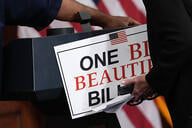You have /5 articles left.
Sign up for a free account or log in.

Istockphoto.com/gazanfer
States continue feeling the Great Recession’s effects a full decade after its end, according to a new brief from the Pew Charitable Trusts, which gives a sobering look at states’ current financial condition and points to significant ramifications for higher education.
The deep 18-month recession, which officially ended in June 2009, led to states forgoing at least $283 billion in tax revenue between 2008 and 2013, Pew estimated. Federal stimulus money offset some of the missed revenue in the short term, and tax collections nationwide have recovered to the point where states took in 13.4 percent more in 2018 than they did a decade prior, after adjusting for inflation. But nine states still were collecting less in tax revenue in 2018 than they were at their pre-recession peak.
Nationwide, states’ general fund spending was 4.3 percent higher in 2018 than it was in 2008. Conditions still varied from state to state, with 23 spending less than they did in the 2008 fiscal year, even after accounting for inflation. For the 2019 fiscal year, an estimated 17 states will spend less than they did before the recession.
Some programs fared better than others, even in states where spending has risen. Over all, the picture is one where states had less to spend on priorities like infrastructure, pensions and higher education than they otherwise might have had. Higher ed, which is the third-largest piece of state budgets, was hardest hit, said Barb Rosewicz, project director of Pew’s Fiscal 50 project on states’ fiscal health.
“This was the most widespread example we encountered of a lingering consequence from the Great Recession,” Rosewicz said. “Higher ed spending was below pre-recession levels in a total of 40 states.”
Pew cited data from the State Higher Education Executive Officers association showing that state financial support for higher ed was 13 percent below its pre-recession level on a per-student basis in 2018, after adjusting for inflation. Tuition revenue has taken on a larger role in funding public higher education, and public universities are collecting 43 percent more in tuition dollars on a per-student basis in 2018 than they did in 2008, after accounting for inflation.
The trends aren’t uniformly negative when it comes to public funding for higher ed, however. State support, which initially dropped after the recession, has been expanding nominally for seven straight years (when including preliminary data for 2019).
Meanwhile, state funding for K-12 education fell on a per-pupil basis in 29 states between 2008 and 2016. State investment in infrastructure projects like highways is at its lowest level in over 50 years. And state aid to local governments across the country had yet to recover to pre-recession levels as of 2016. States had 132,300 fewer noneducation employees in 2018 than in 2008. At least 19 states carried smaller rainy-day funds in 2018 than they did in 2007, when measuring rainy-day funds as a share of general fund operating costs.
Signs also indicate two key state funding priorities that compete with higher ed -- pensions and Medicaid -- will suck up more state spending in the future. States spent more on Medicaid after the recession hit, as enrollment jumped when workers lost jobs and moved onto the rolls of the health insurance program for low-income Americans. Going forward, many states are expected to spend more on the program as they start to take on a small share of the cost of expanding coverage under the Affordable Care Act, which the federal government had covered through 2016. Medicaid spending accounted for 17.1 cents of every state-generated dollar in 2016, up from 14.3 cents in 2007.
Gaps in pension funding increased post-recession. In 2016, states only had enough to cover 66 percent of total pension liabilities, down from 88 percent in 2003.
Funding for pensions and Medicaid are of particular concern to some higher ed observers because they are considered fixed costs that states can’t easily cut. States being locked into spending more on competing priorities puts pressure on parts of the budget that can be adjusted more freely, like spending on higher education.
The current financial situation increases the risk that reduced levels of support for services will be locked in place if another recession hits before states can fully recover from the last one, according to Pew.




